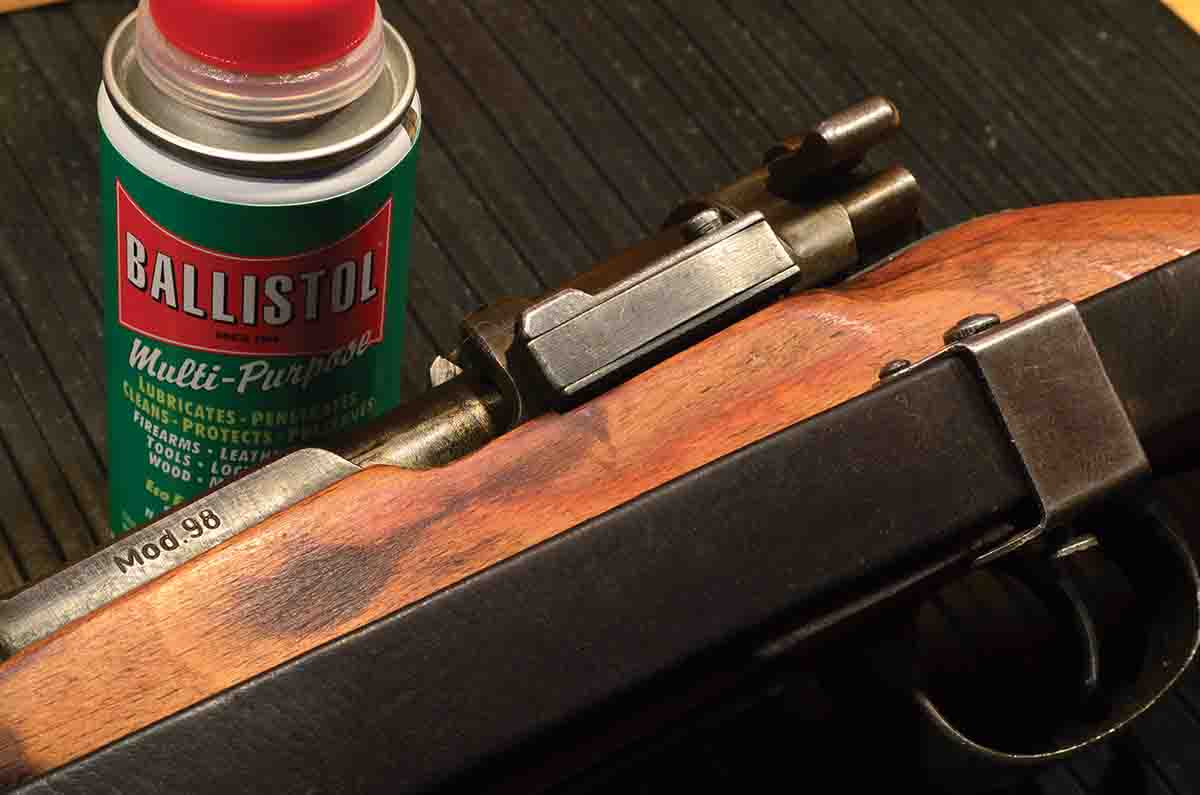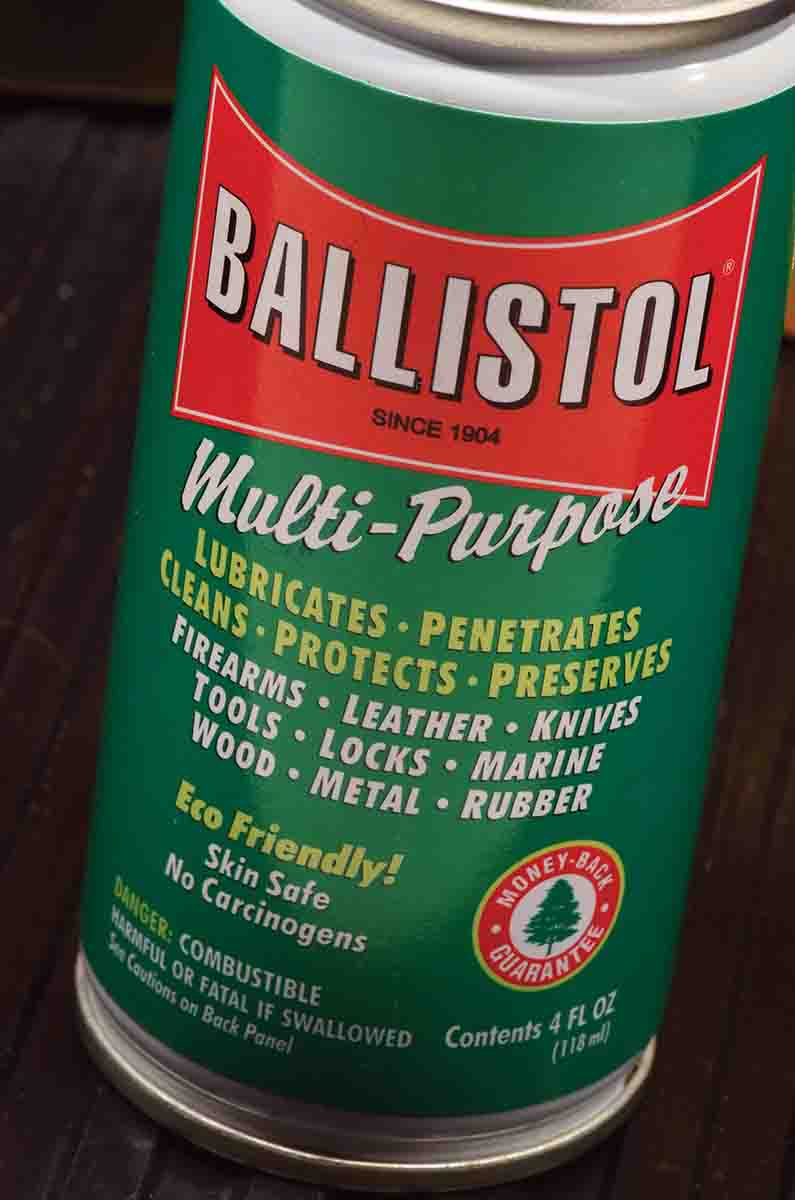Walnut Hill
Ballistol for Nearly Everything
column By: Terry Wieland | November, 18
There was a time – not that long ago – that if you neglected to clean a rifle regularly, you could pick it up one day and find the barrel rusted, the bore pitted, accuracy nonexistent and the action turned to scrap metal.
There were several causes: Corrosive primers fostered rust, ingredients in gunpowder mixed with water to form acids and ate away at things, and salt from fingerprints etched patterns in the steel.

In those days, riflemen became intimately familiar with their guns because they were constantly dismantling them, checking parts and servicing intricate mechanisms. That, alas, is a valuable aspect of shooting that has been largely lost, simply because we no longer have an overwhelming requirement to clean guns regularly. Unless a rifleman has a deep interest in how things work, there is really little requirement to take much apart.
The average owner of an AR, shooting modern .223 Remington ammunition, could go indefinitely without cleaning it, and the only risk would be a slight loss of accuracy due to cuprous fouling. As for the standard, greased .22 rimfire, unless a rifle was dropped in a river, you could literally never run a cleaning rod through it, and neither it nor you would suffer any ill effects.
Old habits die hard, however, and those of us who were commanded from an early age to clean our rifles mostly still do it. In some cases there is a valid reason, such as shooting jacketed bullets at high velocity through bores that are expected to deliver tiny groups. Cuprous fouling degrades accuracy, and it needs to be kept under control. Being a lifelong addict to the entrancing scent of Hoppe’s No. 9, I used it for years even though the original formula does little about the cuprous-fouling problem. Benchrest 9, which contains a generous dollop of ammonia, handles it nicely, although it does require a few days of repeated applications.
A couple of years ago, I tried a few different things and settled on Wipe-Out. It’s a foaming cleaner that you spray in the bore, leave for a few minutes, swab it out and keep going until patches come out without a trace of blue. It doesn’t smell very nice, and it’s hard on finished wood surfaces if it’s spilled, but it sure gets the copper out.
For old times’ sake, I open my bottle of Hoppe’s No. 9 and leave it on the bench while I’m working, thereby getting a clean bore and olfactory gratification at the same time.
My other standard now is a venerable German product, Ballistol, which is an oil more than anything. It was born in the era of corrosive priming, so it does combat that problem – and much more besides. According to the label, there is almost nothing this stuff won’t do, from acting as a penetrating or cutting oil, to preserving wood and leather, to the usual rifle applications of copper, lead and black-powder fouling. For anyone not familiar with Ballistol, there is a story attached that is worth telling. This stuff is the most useful liquid known to man other than water and, perhaps, single malt scotch.

Ballistol was developed for the Imperial German Army before the Great War and has been in continuous service ever since. It was the universal lubricant and conditioner used for every imaginable purpose – and some you are unlikely to guess. Unlike most gun oils, it’s billed as “eco friendly” and will not harm your skin. No one was thinking “eco friendly” in 1904, so that’s probably just a fortunate happenstance. It was developed at the Technical University of Karlsruhe by a chemistry professor, Dr. Helmut Klever. His instructions were to develop a multipurpose oil that could be used not only on a rifle’s steel parts, but on the wood stock and a soldier’s leather equipment as well. It was adopted in 1905 and stayed in continuous service, officially, until 1945. By that time it was also widely used by civilians.
As most of us have discovered, any good leather treatment is also beneficial for the hands, and Ballistol is no exception. However, that barely scratches the surface of its uses. During the Great War, German soldiers in the trenches on the western front used Ballistol not only on their boots but directly on their feet to combat trench foot. Philip Kerr’s fictional Berlin detective, Bernhard Gunther, was a Great War veteran and in his novels mentions treating his feet with Ballistol, the “soldier’s friend.”
They also found – don’t ask how – that it could be taken internally as a “medicine” and successfully treated intestinal problems with it. In the trenches there was no shortage of those. After the war Ballistol’s use became widespread, and it was touted as a remedy for all kinds of gastric disorders.
Adolf Hitler was a frontline soldier from 1914 to 1918 and became such an admirer of Ballistol that he included it in the various medicines he ingested in the 1930s. At one point he was very nearly poisoned, possibly by overdosing. The incident was kept secret, but at least two of his biographers mention Ballistol as the suspected culprit. In Hitler: 1889-1936 Hubris, Sir Ian Kershaw wrote that Hitler was taking Ballistol at the time while John Toland in his book, Adolf Hitler, says that his medicines included “Neo-Ballistol,” a commercial remedy that contained “fusil oil.” Indeed it did.
The Ballistol label today reads “Multi-Purpose – Lubricates, Penetrates, Cleans, Protects, and Preserves” firearms, leather, knives, tools, locks, marine wood, metal and rubber. Furthermore, it is “Eco Friendly! Skin Safe, No Carcinogens.” Even the propellant gas used in the aerosol cans is nonpolluting. As if that were not enough, Ballistol can also be used as an insect repellent and a sunburn treatment. The containers do, however, include warnings that it may be “harmful or fatal if swallowed,” which may or may not be merely a nod to health regulations.
Neo-Ballistol, the pharmaceutical Toland mentions, is still commercially available in tablet form, and the label closely resembles the one on my cans of gun treatment, confirming its ancestry. Not suffering from gastric disorders, I can’t attest to its efficacy in that regard, but having a liquid I can spray on a cloth and wipe down an entire rifle – steel, wood and leather sling – is both convenient and comforting, and nothing I’ve treated thusly has rusted, rotted or deteriorated. A friend of mine, who had a padlock on a trailer that resisted all attempts to open, doused it with Ballistol and waited an hour. It opened like a charm – for the first time in years.
On a trip to the range a few days before I wrote this, I got into a nest of chiggers and the bites resisted every known itch treatment. In desperation, I dabbed on some Ballistol. The itching did not disappear entirely, but it did become bearable.
Many of today’s cleaners, solvents and treatments are so specialized and require such precise application that they make the moon landing seem easy. With Ballistol, the instructions are simple: Spread it on everything and don’t worry. In our modern age of ultra-specialization, having such a useful, general-purpose product is a great relief – a throwback to an age that may have been less exact but was, in many ways, a lot easier to live with.


